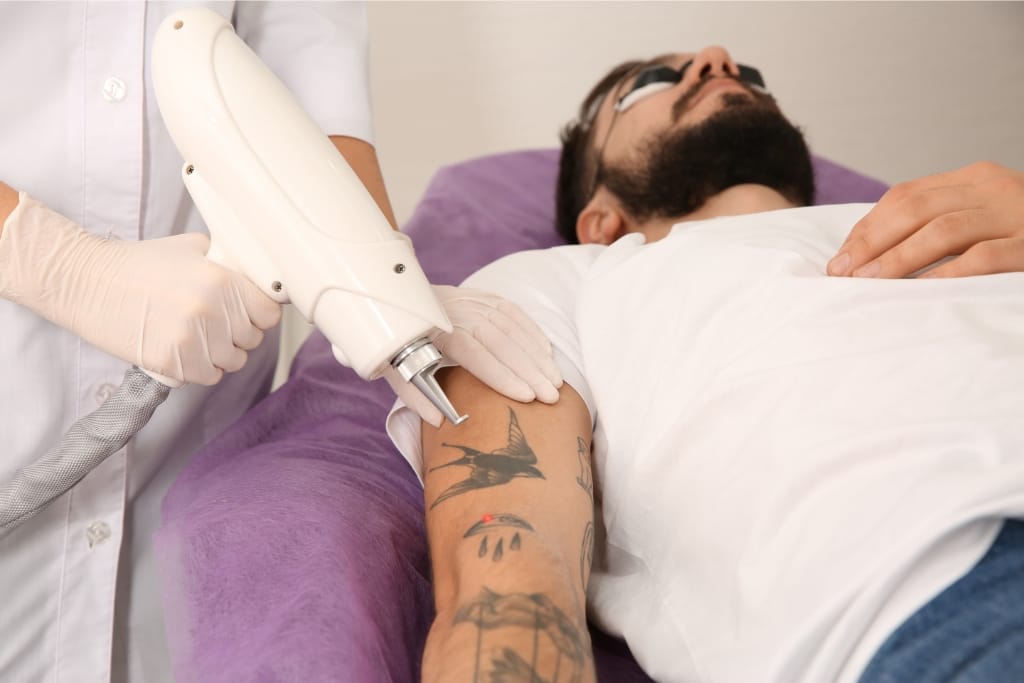Deciding to remove a tattoo is a significant choice that involves careful consideration of various factors.
Whether it's a matter of changing aesthetics, professional requirements, or personal reflection, tattoo removal can be a transformative process.
Before committing to this decision, it's essential to weigh all aspects involved, from the techniques available to the potential challenges you might face.
Gain insights into what to expect and how to navigate the journey effectively.
Explore the key factors to ensure a smooth and informed tattoo removal experience. Read on to discover the critical elements you need to consider.
1)) Type Of Tattoo Ink Used
Understanding the type of ink used in your tattoo is crucial for effective removal, as different pigments and ink compositions can affect how well and how quickly a tattoo can be erased.
Traditional black ink, being more absorbent to the laser wavelengths used in removal processes, often fades faster compared to colors like green, blue, or yellow, which may require more specialized treatment.
Professional tattoos typically use higher-quality, dense inks that can be more challenging to break down than the lighter or inconsistent pigments found in amateur tattoos.
Researching the specific ink types present in your tattoo can help forecast the number of sessions needed and potential outcomes, ultimately guiding you toward an informed decision when planning your removal journey.
Being aware of these differences ensures you are prepared for the possible complexities involved in achieving the desired results.
2)) Size And Color Of The Tattoo
The size and color of your tattoo are significant factors in determining the complexity and duration of the removal process.
Larger tattoos naturally require more extensive treatment areas, leading to a higher number of sessions to achieve complete removal.
Similarly, the color palette of your tattoo plays a crucial role; while darker hues like black and dark blue are generally easier to target with lasers, lighter shades such as yellow, pastel, or even white can be notoriously stubborn.
This variance arises from the way different colors absorb laser wavelengths, with some colors requiring specific laser settings or types to break down effectively.
To anticipate the commitment necessary for your tattoo removal, it's important to assess both the size and color components, recognizing that these elements dictate the scope and intricacy of your removal experience.
With this understanding, you can better prepare for the journey and expectations ahead.
3)) Location On The Body
The location of your tattoo on the body can significantly influence the ease and success of its removal.
Areas with robust blood circulation, such as the arms and chest, typically experience faster and more effective fading because efficient blood flow aids in healing and the breakdown of ink particles.
In contrast, tattoos located on areas with less circulation, like the lower back or ankles, may take longer to diminish, as reduced blood flow can slow the removal process.
The sensitivity of the skin in different areas can affect your comfort during treatment and the potential for side effects such as blistering or scarring.
Understanding how the tattoo's location impacts removal is vital for setting realistic expectations and preparing for the nuances of the procedure.
Equipped with this knowledge, you can tailor your approach to accommodate the specific challenges posed by your tattoo's placement, paving the way for a smoother experience.
4)) Age Of The Tattoo
The age of your tattoo is a critical factor that can significantly affect its removal.
Older tattoos generally fade more easily and require fewer laser sessions compared to newer ones.
This difference stems from the natural fading process, where over time, tattoos tend to lose some of their vibrancy as the ink particles gradually break down and disperse within the skin.
Consequently, the laser's job becomes somewhat easier when targeting these weakened pigments.
Conversely, fresher tattoos might present a bigger challenge, as the ink is still dense and vibrant, often necessitating more intensive treatment.
By assessing the age of your tattoo beforehand, you can better gauge the likely effort and time needed for effective removal.
Armed with this insight, it's easier to approach the process with a well-informed perspective, maximizing anticipation and preparation for each session's demands.
5)) Skin Type And Tone
Skin type and tone are essential considerations when it comes to tattoo removal, as they can influence both the procedure's effectiveness and the likelihood of side effects.
Individuals with lighter skin tones typically experience more efficient removal because the contrast between their skin and the tattoo allows the laser to target ink pigments more selectively without affecting the surrounding skin.
Meanwhile, those with darker skin tones may face additional challenges, as the laser must be adjusted carefully to minimize harm to the skin's melanin, potentially requiring more sessions and expert handling.
Skin type also plays a role, with certain types being more prone to side effects like hyperpigmentation or scarring.
Evaluating your skin's unique characteristics can help you and your practitioner devise the most appropriate and safe approach for removal.
By understanding these aspects, you can navigate the tattoo removal process more confidently, optimizing outcomes while mitigating risks.
6)) Available Removal Techniques
The range of available removal techniques offers flexibility and options to those seeking to eliminate unwanted tattoos.
Among the most common methods are laser removal, dermabrasion, and surgical excision.
Laser removal is often the preferred choice due to its precision and the advancements in technology that have increased its effectiveness for various ink colors and skin types.
Dermabrasion involves sanding down the skin to remove the ink, while surgical excision, which is more invasive, entails cutting out the tattooed skin and stitching the remaining skin together.
Each technique has its risks, benefits, and suitability depending on the individual's skin type, tattoo size, and location.
Understanding the array of techniques allows for a more personalized and informed decision, ensuring that the chosen method aligns with your specific needs and circumstances, and facilitating a successful tattoo removal journey.
7)) Number Of Sessions Required
The number of sessions required for tattoo removal is a pivotal factor in the overall process, as it influences both the timeline and cost.
Several variables come into play when determining session count, such as the size, color, and depth of the tattoo, alongside individual factors like skin type and immune response.
The spectrum of ink colors used in a tattoo can significantly dictate session length; while black ink is absorbed more effectively, vibrant colors like blues and greens may demand additional sessions to achieve optimal fading.
The tattoo's depth also plays a crucial role, with more superficially placed ink particles needing fewer sessions for removal.
Both patience and consistency are key, as multiple treatments allow the skin to recover and the body to process the fragmented ink particles after laser exposure.
By comprehending these elements, you can better manage your expectations and prepare for the entire removal journey, ensuring each step aligns with your personal goals for a successful outcome.
8)) Cost Of Tattoo Removal
The cost of tattoo removal is a significant consideration for anyone contemplating this procedure, as it can vary widely based on several factors.
These factors include the size and complexity of the tattoo, the removal technique chosen, and the number of sessions required.
Larger tattoos with intricate designs typically come with higher removal costs due to their scope and the extended time needed for complete erasure.
The choice of removal technique—such as laser removal, dermabrasion, or surgical excision—can greatly impact the overall cost, with laser removal, often considered the most efficient method, having a commensurately higher price tag.
The number of sessions needed not only affects the cost in terms of recurring fees but also relates to the overall investment in time and resources.
Balancing these factors against your budget is crucial for planning tattoo removal.
By closely evaluating the expenses involved, you can make a financially informed decision and pursue tattoo removal with clarity and confidence.
9)) Potential Side Effects And Risks
The potential side effects and risks of tattoo removal are critical considerations that can influence the decision-making process.
As with any medical procedure, tattoo removal, particularly laser-based methods, carries the risk of certain side effects such as redness, swelling, and discomfort in the treated area.
Hyperpigmentation or hypopigmentation may occur, especially in individuals with darker skin tones, as the laser can sometimes affect the skin's natural melanin production.
Scarring is another potential risk, depending on the individual's skin type and the care taken after the procedure.
Infection, while rare, is a possibility if the treated area is not properly cleaned and cared for.
To minimize these risks, it is essential to choose a qualified, experienced practitioner and follow all recommended aftercare instructions.
By thoroughly understanding and preparing for these potential side effects and risks, you can better protect yourself and ensure a smoother, safer tattoo removal experience.
10)) Choosing A Qualified Professional
Choosing a qualified professional for tattoo removal is a crucial step toward achieving the desired outcome with minimal risk.
An experienced practitioner not only brings expertise in the latest removal techniques but also can tailor the procedure according to your individual needs, ensuring better results and reducing the likelihood of side effects.
Thoroughly researching potential professionals, including verifying their credentials and experience, becomes imperative in this regard.
Recommendations from previous clients or reviews on trusted platforms can provide insights into a practitioner's reliability and success rate.
Furthermore, a certified professional will conduct a comprehensive assessment of your tattoo and skin type before proceeding, which is essential for crafting a personalized treatment plan.
Establishing open communication and feeling comfortable with the chosen specialist can greatly enhance the overall experience.
By selecting a qualified professional, you are laying a strong foundation for a safe and effective tattoo removal process, leading to a more satisfying journey and final result.
Conclusion
Embarking on a tattoo removal journey requires careful consideration and planning to ensure the best possible outcomes.
Understanding the intricacies of the removal process, from the number of sessions needed to the cost and potential side effects, empowers individuals to make informed decisions.
Selecting a qualified professional plays a pivotal role in enhancing safety and effectiveness, offering peace of mind throughout the procedure.
By approaching tattoo removal with a comprehensive understanding and strategic preparation, you can confidently navigate each step, transforming aspirations into reality and achieving your personal goals.
Download Our Free E-book!








